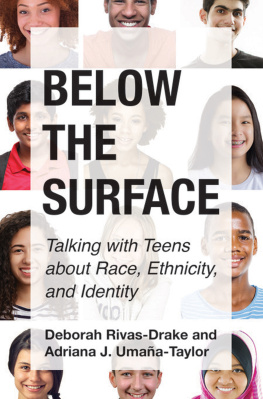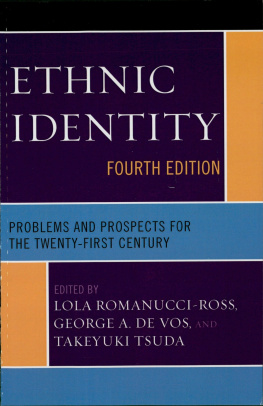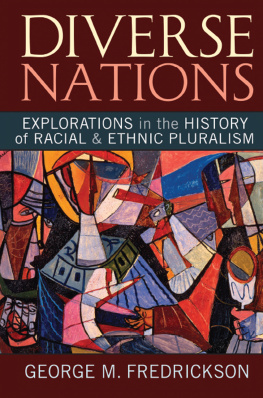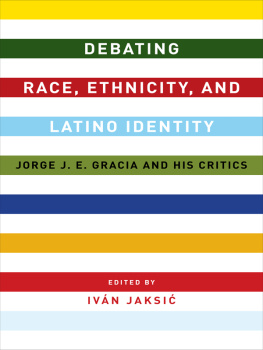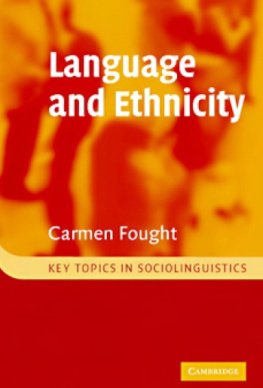
BELOW THE SURFACE
Below the Surface
Talking with Teens about Race, Ethnicity, and Identity
Deborah Rivas-Drake
Adriana J. Umaa-Taylor
PRINCETON UNIVERSITY PRESS
PRINCETON AND OXFORD
Copyright 2019 by Princeton University Press
Published by Princeton University Press
41 William Street, Princeton, New Jersey 08540
6 Oxford Street, Woodstock, Oxfordshire OX20 1TR
press.princeton.edu
All Rights Reserved
Library of Congress Control Number: 2018943161
ISBN: 978-0-691-17517-1
British Library Cataloging-in-Publication Data is available
Editorial: Meagan Levinson and Samantha Nader
Production Editorial: Ellen Foos
Jacket/Cover Design: Lorraine Doneker
Jacket images courtesy of Shutterstock
Production: Jacqueline Poirier
Copy Editor: Cathryn Slovensky
This book has been composed in Adobe Text Pro
Printed on acid-free paper.
Printed in the United States of America
10 9 8 7 6 5 4 3 2 1
CONTENTS
For Tom, Liliana, and Diego, who remind me every day of what is at stake.
To Bianca, Mateo, Toms, and all children living in culturally diverse societies who need brave adults in their lives to engage in the difficult conversations of race, ethnicity, and social justice.
ACKNOWLEDGMENTS
I (Debbie) would like to thank my dear friends and close colleagues (you know who you are): Thank you for every open and generous conversation about race (and everything else) weve been able to have together. I appreciate you so very much. Thanks, too, for the laughter and side-eye when one of us gets it wrong, and for all that I have been able to learn by knowing you. Thank you to my students at the CASA Labespecially Mike, Abby, Tissyana, Fernanda, Aixa, Kevin, Mercy, Adam, Luis, Bernardette, Stephanie, Delina, Erika, Jess, and Josefor all your support and encouragement of this work.
Thank you to my parents and my sister. My parents were my first and most important teachers of the value of a strong work ethic (immigrants get the job done!). I also feel lucky that I had the opportunity to spend my formative childhood years in Woodside, Queensa child of immigrants growing up amid other immigrants from all over the world. You didnt do this intentionally, but it has profoundly shaped who I am. Monica: Thank you for reflecting on these experiences with me, challenging me to defend my ideas, and for just being such a supportive person in my life.
Finally, and most importantly, I am incredibly grateful to my partner and children. Tom, thank you for your patience, support, and advice. You are my partner in all things, and I could not have written this book without your unwavering belief in methank you. Diego and Liliana: You are my most important inspiration for this book. I wrote with you in mind, hoping that in some way, however modestly, the ideas within may contribute to a more socially just world. I also hope that when you read it one day (soon), youll challenge me to think even more deeply about these issues.
I (Adriana) would like to recognize many people who made this work possible. First, I want to thank Matt for his constant, unwavering support and for believing in me and in the importance of this topic. His sacrifices along the way, including many stretches of single parenthood while I traveled to Michigan or extended conference trips to write, did not go unnoticed. I also thank Bianca, Mateo, and Toms, who unknowingly gave up time with me, and who also served as a constant motivating factor for the importance of this book. Their experiences in school and with peers, their random questions or comments that inevitably led to a conversation about social justice, and our specific conversations about their multiethnic heritage were a constant inspiration for me. I am also grateful to friends and colleagues who shared their personal stories with me and helped me think deeply about this book from a parents, rather than a scholars, perspective. Finally, I thank the many students and research staff who made this book better by providing feedback and helping with research along the way: Michelle Capriles-Escobedo, Olga Kornienko, Stefanie Martinez-Fuentes, Anne Mulligan, M. Dalal Safa, Danielle Seay, Benjamin Smith, and the students of the CASA Lab at Michigan.
PREFACE
The motivation to write this book was complicated. As researchers, were accustomed to sharing our ideas in scholarly articles in academic journals, to be read, for the most part, by other researchers. But in writing this book we aspired to reach a broader audience, and doing that somehow makes this endeavor feel more personal. It represents our contribution to a larger conversation, one for which there is no single entry point or exit. We hope readers will see themselves in dialogue with the ideas in this book and that theyll see the relevance to their daily lives and work.
As researchers, we are trained to stay close to the findings themselvesthat is, we are taught (and teach our graduate students) to not overstate results of our research, because they are meant to be incremental. Indeed, our training leads us to understand that, over time, a body of literature can speak more definitively about an issue relative to any single study. From our perspective, this is, in fact, where we currently find ourselves in the literature on ethnic and racial identity. We felt it was time to share what we know from the field of ethnic and racial identity research in youth with people who, for many reasons, might never pick up an academic journal article, much less read an entire body of work spanning multiple decades.
We were particularly motivated to write this book because, when we look around us, what we see are many missed opportunities to use what the research says to address everyday race relations among young people in schools and communities across the United States. As parents and educators ourselves, we immediately sensed a need for an introductory book that would help our friends, neighbors, students, and practitioner colleagues make connections from theory and research to their everyday experiences. To do this, we have tried to write in an intuitive way for anyone interested in gaining insight into how youths identity is linked to race relations and who strives to support positive intergroup relations in the next generations of youth in the United States. We envisioned this book being read by parents, teachers, educators, school administrators, and clergyessentially, any professional engaged with youth. As college professors who have taught thousands of students over the course of our careers, we also wrote with our past and future college students in mind.
What we offer you is a synthesis of current research that addresses how features of social spaces and situations intersect with youths identity development to promote better relationships. Throughout the book, we draw from researchincluding our ownto provide a comprehensive yet concise introduction to psychological research on the development of ethnic and racial identity and intergroup relations among diverse youth in the contemporary United States. We also draw numerous examples from popular films, TV shows, websites, novels, and memoirs, as well as existing programs and curricula, to bring theoretical ideas to life. In doing so, we address different types of ethnic and racial diversityfor instance, being Black in a Latino school, diverse Asian American anecdotes, Multiracial perspectives, and so onthat more accurately reflect the sorts of experiences that are likely to become more prevalent among US youth in the coming decades.
Next page
